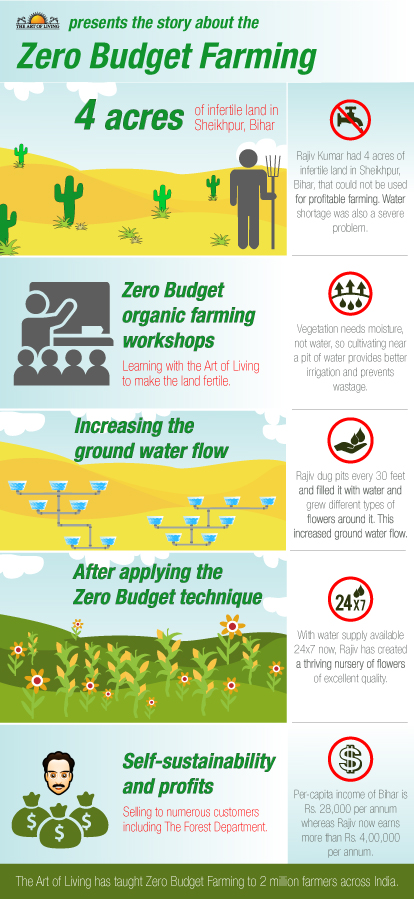Zero Budget Natural Farming (ZBNF) is a farming practice that believes in natural growth of crops without adding any fertilizers and pesticides or any other foriegn elements. The word Zero Budget refers to the zero net cost of production of all crops (inter crops, border crops, multi crops). The inputs used for seed treatments and other inocluations are locally available in the form of cowdung and cow urine.
A ZBNF practicisng farmer has lower cost of inputs and thus has better capacity to increase the incomes. At the same time, ZBNF crops helps in retaining soil fertiliting and is climate change resilient.
Zero Budget Natural Farming (ZBNF) is a set of farming methods, and also a grassroots peasant movement, which has spread to various states in India. It has attained wide success in southern India, especially the southern Indian state of Karnataka where it first evolved. The movement in Karnataka state was born out of collaboration between Mr Subhash Palekar, who put together the ZBNF practices, and the state farmers association Karnataka Rajya Raitha Sangha (KRRS), a member of La Via Campesina (LVC)

The zero budget farming aims at pulling the farmers out of the debt trap that they found themselves in with the liberalisation of Indian economy. This is also an attempt to make small scale farming a viable vocation.
In many states, farmers are in huge debt due to rising agriculture cost on the account of privatised seeds, farm inputs and inaccessible markets. The high-interest rates for credit or loans that the farmers take from the easiest available lender made farming unviable.
Zero budget farming model promises to cut down farming expenditure drastically and ends dependence on loans. It also reduces dependence on purchased inputs as it encourages use of own seeds and locally available natural fertilizers. Farming is done in sync with the nature not through chemical fertilisers.
Andhra Pradesh become India's first Zero Budget Natural Farming state.
Four pillars of ZBNF
Jeevamrutha/Jivamrita:
This is a fermented microbial culture prepared from locally available natural resources for the purpose of being applied to the soils/plants at different stages of their growth. It is a form of bio-fertilizer, a catalytic agent, promoting microorganism and earthworm activity in the soil. The 48 hour fermentation process multiplies aerobic and anaerobic bacteria present in the cow dung and urine, as
they eat up organic ingredients, and a handful of undisturbed soil acts as inoculate of native species of
microbes and organisms. Its application acts as a preventive measure against fungal and bacterial diseases. It can be applied through irrigation water or through foliar spray. While transiting from
conventional input-intensive agriculture, the application of Jeevamrutha to the soils and plants is required only for the first three years because after that the system becomes self-sustaining.
Beejamrutha/Bijamrita:
This is a concoction prepared from locally available natural resources for the propose of treatment for
seeds, seedlings or any planting material. It reduces the possibility of seed infestation by pests and
protects young roots from fungus, soil-borne diseases, and seed-borne diseases that generally affect
the plants after monsoon. In the ingredients, the dung and urine from the indigenous breed cow act as
a powerful fungicide, and anti-bacterial agent, respectively.
Acchadana/Mulching:
There are three types of mulching.
1) Soil mulching: It protects topsoil by avoiding tilling. It facilitates aeration, and promoteswater retention. If not zero tillage, avoid deep ploughing.
2) Straw/Biomass mulching: Application of dry organic matter (dead material of any living being) along with Jeevamrutha will lead to decomposition and humus formation that will improve soil fertility.
3) Live mulching: This suggests inter-cropping or mixed-cropping by combining monocots (those seedlings with one seed leaf like rice and wheat) with dicots (those seedlings with two seed leaves like legumes) in the same plot of land. This will create a symbiotic relationship because monocots will supply elements like potash, phosphate, and sulphur, while dicots will work towards nitrogen-fixation.
Whapasa/Moisture:
This calls for an appropriate mix of water and air in the soil or the relevance of soil moisture. It questions the thinking that plants need more water and irrigation is the way out. Rather, it calls for a
reduction in water usage and resonates with the saying "more crop per drop."






0 Comments